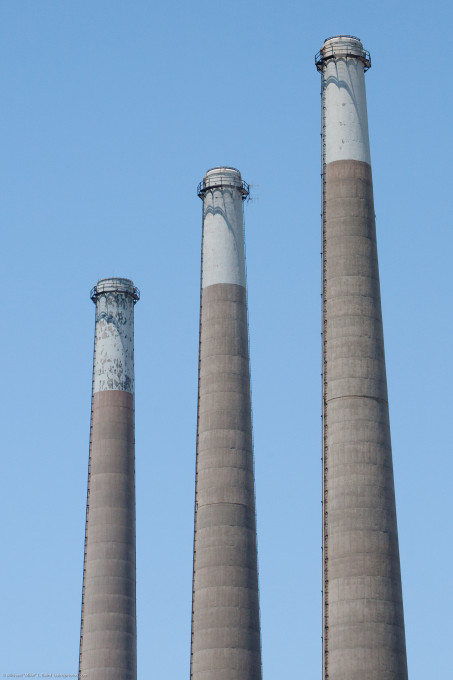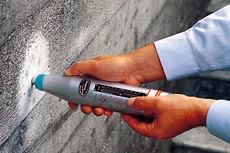What Does an Inspection for Industrial Chimneys & Smokestacks Involve?
 Industrial chimneys and smokestacks are subject to deterioration over time from factors such as temperature excursions, chemical attack, lightning strikes and wind loading. A program of regular, periodic inspections by qualified chimney professionals will help identify early signs of trouble so they can be corrected before they become more costly or pose a danger to health and safety.
Industrial chimneys and smokestacks are subject to deterioration over time from factors such as temperature excursions, chemical attack, lightning strikes and wind loading. A program of regular, periodic inspections by qualified chimney professionals will help identify early signs of trouble so they can be corrected before they become more costly or pose a danger to health and safety.
The most damage and wear-prone areas on a chimney are usually the hardest to see from ground level – the interior, the top, areas around breeching duct inlets, inspection ports, and upper reaches of ladders, platforms and fall-arrest systems. As part of a sound, periodic inspection and maintenance program, a qualified rope access chimney expert can be a key partner for keeping your chimney or smokestack in good working order.
If you are unfamiliar with the components or methods of an industrial chimney or smokestack inspection, here’s a brief summary of what you can expect.
Visual Inspections
Before a chimney technician will be able to determine the condition of the structure and the extent of any maintenance needed, a preliminary visual inspection is required. The American Society of Civil Engineers publishes guidelines for the inspecting all types of chimneys and stacks. The Class I inspection is a visual inspection using binoculars from ground level, and close-up visual inspection from ladders, platforms and any other accessible points that offer a good view of the structure. An exterior inspection of the structure can be done with the system on-line. Class I inspections should be done every year to identify early any potential problems that may be developing.
Class II Inspections are performed with the chimney or stack off-line. They require a close-up physical inspection of the structure exterior and interior. Rope access techniques give technicians a close-up, “hands-on” view of the structure both inside and out. The inspection process begins with a project-specific safety plan, assuring safe access to the structure and a “rapid response” rescue plan for any emergency situations that may arise during the course of the work.
Once underway, the work begins with installation of rigging at the top of the stack from which the chimney technicians will make one or more descents down the entire elevation of the structure. Written notes and color photographs are taken at fixed intervals, usually every ten feet to every twenty feet depending on the type and size of the structure. Notes are made of any abnormalities, wear, damage and safety hazards detected from the visual inspection and an initial report is given to the company/facility manager identifying any urgent concerns and required repairs. A detailed report with photographs, field notes, measurements, readings and recommended actions is then written and delivered to the customer.
Nondestructive Testing
There are a number of nondestructive testing methods (NDT) that can be used during Class II inspections to provide a information about the structural integrity of an industrial chimney or smokestack. NDT methods examine structures in a manner that does not affect the usefulness or performance of the material. NDT allows testing and measurement of physical characteristics such as the thickness of steel or fiber reinforced plastic (FRP) or the hardness of concrete without damage to the structure.

The Schmidt Hammer NDT is a great way to test the strength and structural integrity of an industrial chimney.
Some types of nondestructive tests include:
-
Ultrasonic Thickness testing (UT) – determines the relative thickness of the material at various coordinates, to detect any areas of wear and thinning.
-
Schmidt Hammer (rebound hammer) Testing – measures the strength of concrete based on surface hardness and resistance to penetration.
-
Laser Surveys – allows accurate measurement of distances, angles and other physical characteristics of structures to determine deviations from original “as-built” conditions.
- Hot Camera Inspection – this may be an acceptable solution for plants or factories that cannot schedule an outage at the time an inspection is due. An insulated video camera is lowered down the operating chimney or smokestack while it is still online. Since variations in flue gas opacity can result in “foggy” images and the camera will be taking images from several feet away from the liner surface, hot camera inspections do not provide the detail & clarity that direct observation does. Although good for detecting large deficiencies like damaged or missing brickwork and deteriorating liners, a hot camera inspection may miss narrow cracks or the beginning symptoms of spalling.
Material Sampling and Testing
Some circumstances warrant a closer and more detailed look at the physical condition of structures. These might include an initial or baseline assessment of a structure or investigation of an observed deficiency to determine its root cause. In these instances, physical samples of material are removed from the structure and provided to a qualified testing facility for analysis.
Types of testing include:
-
Concrete sample (“core”) testing for assessment of the material’s strength, the extent of any acid attack and corrosion resistance. For this type of test, a special core saw is attached to the structure at various elevations, and a sample is cut and removed. The hole is then patched. Testing the breaking strength of concrete cores (Break testing) is one commonly used method. Another is petrographic analysis, which examines the physical and chemical make-up of the concrete sample to determine if the can be rehabilitated or needs to be replaced.
- FRP (Fiberglass Reinforced Plastic) lab testing. A range of tests for fiberglass materials is available which examine the liner layer, fiber layers, resin and overall condition of the composite. From these, the remaining useful life of the structure can be predicted, and required repairs identified.
Class III Inspections are usually associated with unique circumstances which require an intensive examination of the structure for safety and stability. This may include significant weather impacts (from a tornado or hurricane, for example), earthquake, explosions, overheating and other occurrences. They include all the elements of the Class II inspection plus physical sampling and testing and engineering review.
A prudent inspection program will help maintain structural integrity, control long-term maintenance expenses, and prevent costly and disruptive unplanned facility outages. Even if a chimney or smokestack has been retired, weathering and environmental factors can lead to deterioration, so it’s important to include them in your comprehensive inspection plan.
Contact Industrial Access, Inc. today to discuss inspection program options that will fit in with your company and facility’s needs.



